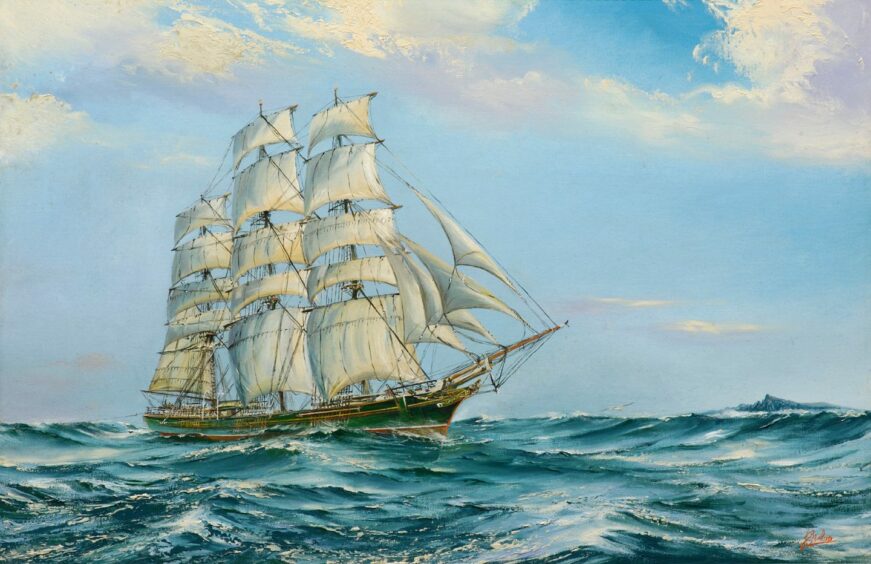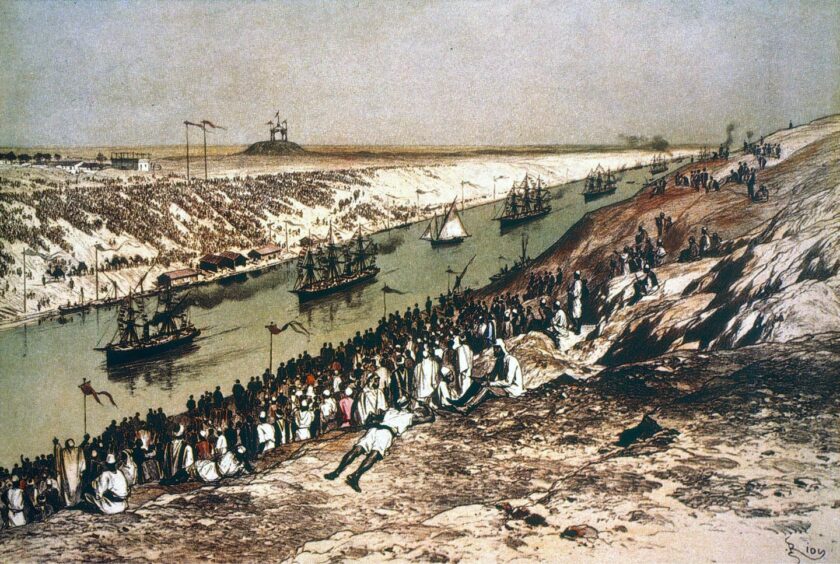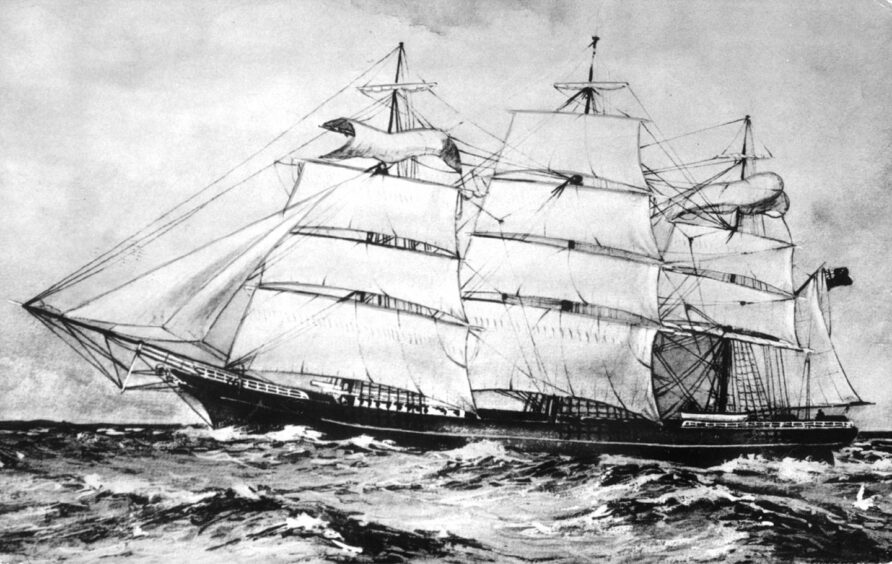
Where would we be without our daily brew? It’s something we take so much for granted it’s hard to imagine a world without tea.
That’s why this weekend a new plaque is being unveiled in Aberdeen to commemorate Thermopylae, one of the most celebrated tea clippers in the world, a technological marvel of her day, built in the Granite City.
Go back three centuries, and China tea was only around in small quantities for the super-rich.
The British East India Company imported most of it in a lucrative monopoly, it was highly taxed by the government and plied its way slowly across the globe in traditional merchant ships.
Then important factors changed.
The government reduced the tea tax in 1773, and the Suez Canal opened in 1869 facilitating much faster trade between east and west.
And like today, technology drove the evolution of trade.
Superbly designed clippers were able to bring back bigger quantities much faster so that tea could become the daily beverage for the entire population.
It undoubtedly saved lives too, as water sanitation at that time was poor to non-existent, and boiling it for tea killed off deadly bugs like cholera.
The only other option at the time was to drink beer or harder stuff, and that brought its own problems.
The ships which brought the tea back from the 1840s onwards century were clippers, light, narrow, designed for speed with three masts and a massive sail area.
Their speed was so revolutionary they were dubbed ‘the greyhounds of the sea’ and they transformed the tea trade.
More than 27,558 tons of the black gold was imported to Britain in 1869 alone.
At the forefront were clippers like the Thermopylae, built in 1868 in the Walter Hood shipyard in Aberdeen.
Thermopylae’s triumphant defeat of the Cutty Sark in 1872 is celebrated in the new plaque, to be unveiled today [Saturday May 20] in the Port of Aberdeen quayside near the Roundhouse and the Silver Darling restaurant.
The plaque was organised by Stanley Bruce, a former employee of the Hall Russell shipyard, and author of 22 books about the Aberdeen shipyards.
It’s the second plaque he’s organised to celebrate Thermopylae.
The first commemorates the ship’s launch in 1868, and can be see inside the bus shelter in York Street.
It was made by Weld-Tech Services in Methlick, under the auspices of director Ricky Somerville, and engraver Gavin Gatt.
The team reformed to create the new one to celebrate the famous 1872 tea race.
Ricky said: “We support the role that the maritime industry has played in shaping the north-east’s past and future and this plaque is gifted to show our gratitude to our forefathers and all the people who remain passionate about promoting our heritage to future generations.”
The plaque lies on a stand, made and donated by Forsyths Ltd.
Stanley said: “People said Cutty Sark was the better ship, but Thermopylae proved she was.
“You’ll see the flag of the Aberdeen White Star line in the top right hand corner.
“George Thompson who established the Aberdeen White Star line not only had the ship designed for speed, he always chose the best Masters, capable of pushing the ship to its fastest.”
Built in the Walter Hood shipyard
The Walter Hood shipyard, opened in 1839, built many of Aberdeen’s famous sailing ships during its 42 year lifespan.
The new plaque is placed as close to the site of the shipyard as possible. If only time travel was possible for today’s visitors to witness the frenetic activity in the yard as the Thermopylae was under construction.
She had a rival under construction in Dumbarton, the Cutty Sark, and the stakes were high in beating her home from China in the legendary annual tea race.
It was a bit like all the noise around the race to get the first Beaujolais Nouveau into London thirty years ago.
Calendar highlight
The tea race was a calendar highlight, with the public flocking to the quayside in London to watch the magnificent spectacle of the clippers speeding home with their precious cargoes of new season tea.
It was all the rage to have a flutter on the tea race, and bets were run on it for weeks.
Prestige for the winner was huge, but most importantly, there was big money in it.
The winning cargo commanded a significantly higher premium, with captain and crew getting their share.
Thermopylae’s pinnacle of glory came in the great tea race of 1872.
She was sleek and fast with an average speed of 16 knots, more than 18 miles per hour, but so was her rival Cutty Sark, designed by Inverbervie man Hercules Linton. There must have been an element of very local rivalry between the two ships.
The Cutty Sark was five inches longer than Thermopylae but registered 27 tons less.
It was reported she could cover a thousand miles in three days.
The ‘wonderful Thermopylae’
Of her Aberdeen rival, the Falkirk Herald said: “The wonderful Thermopylae could do seven knots with so little breeze that a man could walk around her decks with a lighted candle.”
She impressed on her maiden voyage, setting a record of 62 days to Melbourne, knocking weeks off the previous record.
The crew were buoyed up and confident, desperate to pit their ship against the Cutty Sark in the annual tea race.
Thermopylae had already won a tea race in 1869, a year after she was launched.
That year she set off from Fuoochow (Fuzhou) on July 3 and made the journey in 88 days, beating her rival, Spindrift, by six days and setting a record.
Up to that point any Aberdeen ship in the race from Fuzhou had been in the late sailings, so Thermopylae broke the mould.
“There will be proud folk in the ‘braif toun’ this day, and long faces in Glasgow,” wrote the London Scotsman.
On June 26, 1872 Thermopylae and Cutty Sark slipped anchor in Shanghai and raced neck and neck through the South China Seas.
Just as it looked like the Cutty Sark was pulling ahead she lost her rudder in a storm off the notorious Cape of Good Hope, South Africa.
She had to hove to for six days to make urgent repairs, and thereafter was forced to cut her speed down, allowing Thermopylae to regain the lead and hold it for the rest of the race.
Thermopylae arrived in London a full nine days ahead of her rival, and great were the celebrations.
Technology moved on
But the days of the clippers were numbered.
After 1872 the legendary tea races declined, as technology had evolved again and steam vessels powered in to take over from sailing ships.
Whereas clippers could carry up to 1200 tons of tea, the steamers could carry 4,000 tons and more.
From 1882 onwards, Thermopylae only took part in the Australian wool trade; on this route Cutty Sark proved faster however, as Thermopylae excelled in light winds. This was to her benefit in getting back to London over the South China Seas, but the advantage disappeared on the Australian home route.
She plied wool from Sydney up until 1890 when she was sold to Canadian owners and used in the timber trade, albeit with reduced rigging.
In 1895 she came to Leith and was sold to the Portuguese government for use as a naval training ship.
Now she became the Pedro Nunes, commissioned into the Portuguese Navy in 1896, but instead of being used for training she was soon reduced to a coal hulk.
In an ignominious end in 1907, she was towed out to the mouth of the Tagus at a Portuguese Navy League regatta and sunk by Whitehead torpedoes.
The Cutty Sark has survived thick and thin, including a fire in 2007, and is now a maritime museum in Greenwich, London.








Conversation